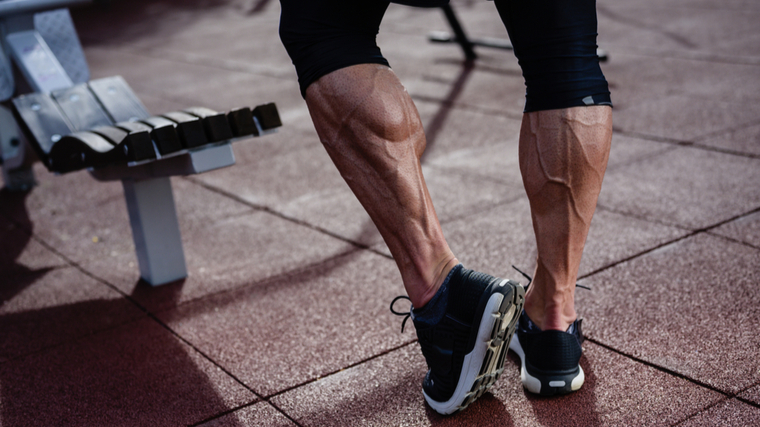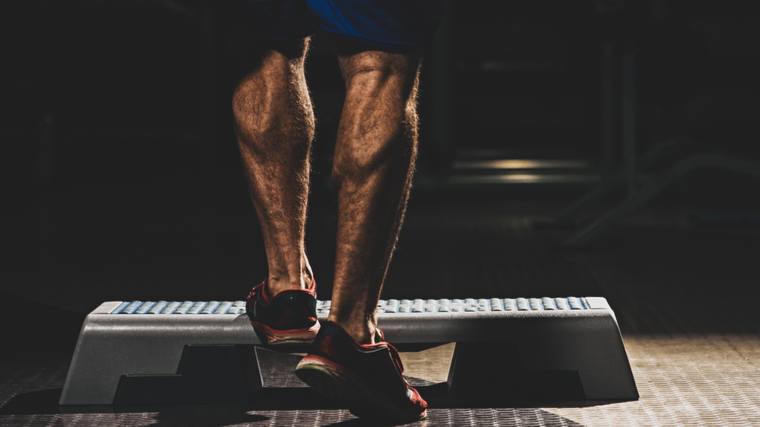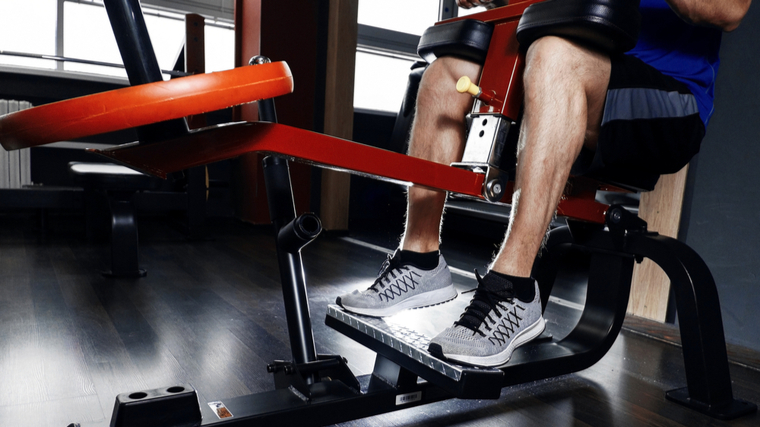If you want to have an impressive set of legs, you have to look below the knee. Building bigger, stronger calf muscles can be tough, however, the task is certainly not impossible. When looking to build bigger calves, you need to attack them often with higher training volumes, frequencies, and a variety of rep ranges to optimally develop the muscles that make up the lower leg.
Strong calves are not just an aesthetic feat, either. They are often responsible for or aid in increased jump height, sprinting capability, and overall lower body explosiveness.

In this article we will discuss the calf raise, and how to incorporate it into your lower body training to build bigger, stronger, more performance-oriented legs.
- How to Do the Calf Raise
- Benefits of the Calf Raise
- Muscles Worked By the Calf Raise
- Who Should Do the Calf Raise
- Calf Raise Sets and Reps
- Calf Raise Variations
- Calf Raise Alternatives
- Frequently Asked Questions
How to Do the Calf Raise
Below is a step-by-step guide on how to perform the calf raise. While there are a few different calf raise variations, this guide will discuss the standing calf raise, which can be done with bodyweight, various types of free weights, or in a Smith machine.
Step 1 — Hang Your Heels

Start by standing on the edge of a stable surface such as a step, block of wood, or anything that is a few inches tall. You want to have your heels able to hang off the edge to allow you to go into a deep calf stretch by flexing your ankle.
Coach’s Tip: The key to a good calf raise is to train in the full range of motion and to get a deep stretch on the muscle.
Step 2 — Stretch and Contract

Stand upright with your foot on the edge of the step or surface, and go into a deep calf stretch while holding a weight. Keep your knee extended. Push through your toes to lift the heels upwards, going into full plantar flexion of the ankle joint. Hold yourself in the top position for a second, focusing on strong muscle contraction, then lower yourself slowly under control.
Coach’s Tip: Prioritize the full stretch and contraction at the top of the raise. Tension and contraction are key in the calf raise, and are more important than using a ton of weight.
Benefits of the Calf Raise
Below are a few reasons why you can benefit from including calf raises into your workout program.
Increased Hypertrophy
The calf raise is an isolation movement that targets the two calf muscles (gastrocnemius and the soleus). Based on the calf raise variation (seated or standing) you will target one of those muscles more than the other — the soleus if the knee is bent, the gastrocnemius if you’re standing.
If you are looking to increase muscle size, you will want to train both seated and standing to ensure balanced muscular development.
More Explosiveness
The calves are responsible for ankle plantar flexion, which is the joint action of pushing off through the toes to propel oneself forward or upwards. This is often the exact reason why stronger and more explosive calves can increase both jumping and sprinting capabilities.
While overall lower body strength is also a key factor in both jumping and sprint performance, having stronger calves and training the muscles of the ankle can have a direct impact on your power output.
Stronger Ankles
Stronger ankles can improve your ability to grow bigger calves, improve sports performance, and keep you training more consistently. The calves work to support ankle stability and knee stability, making direct calf training a smart idea for functional fitness athletes, runners, or anyone else who may be susceptible to ankle sprains and injuries.
Muscles Worked By the Calf Raise
The calf muscles are made up of the gastrocnemius and the soleus. Both muscles are responsible for flexing the ankle joint.
Gastrocnemius
The gastrocnemius is one of the muscles of the calves responsible for ankle plantar flexion. Unlike the soleus, it also assists somewhat in knee flexion as it crosses the knee. Due to the attachment location of the gastrocnemius, calf raises done from a standing position tend to target the gastrocnemius more than the soleus.
Soleus
The soleus muscle is part of the calf muscle group, and is also responsible for plantar flexion of the ankle. Unlike the gastrocnemius, the soleus does not attach above the knee, and therefore is more isolated when calf raises are done from a seated position.
Who Should Do the Calf Raise
Calf raises can be done for aesthetic reasons as well as to accrue performance benefits. Some individuals may need to train the calves more than others, however, below is a general overview of who can benefit from training their calves.
Strength Athletes
Building stronger calves can aid in squat and deadlift strength, increase ankle stability, and have a positive impact on overall athletic performance. Movements like heavy carries, stone lifts, and push presses all require strong ankles.
While direct calf training may not be necessary for every type of athlete — as general training may provide enough indirect calf work — additional calf isolation exercises within a training program may benefit some athletes.
Olympic Lifters
Weightlifters rely on a strong extension of their ankles, knees, and hips to generate an upward force upon the barbell during the snatch, clean, and jerk. While calf raises may not be a common movement used in weightlifting training, some lifters may find them helpful to add if they are lacking in extension strength.
Bodybuilders
Any aspiring bodybuilder should know they have to train every muscle in their body to look good — including their calves. Whether you dream of stepping on stage or not, underdeveloped calves can hamper the appearance of your legs overall and contribute to an “imbalanced” look.
Calf Raise Sets and Reps
If you are looking to increase the size of your calves, modify the strength and power of your lower body, or want to improve stability at the joint, the below guidelines can be used to program direct calf training within your program.
To Build Muscle
To gain muscle mass, you will need to attack the tissue with a more isolated approach. While some individuals may have a harder time growing their calves than others, anyone can put on muscle mass around their calves if they work hard enough.
To bring up your calves, start by increasing your training frequency. Work up to sessions 3 – 4 times per week, aiming to hit up to 20 sets overall. Your rep ranges can vary between 5 – 10, 10 – 20, and up to 30 reps per individual set. Start on the lower end of the volume, assess your ability to recover, and work up from there.
To Increase Strength and Power
Most athletes will be able to increase the strength and power of their calves by lifting heavier loads for 5 – 10 reps, or simply by performing their sport-specific tasks like heavy clean pulls, sprinting, jumping, and sled work.
For direct calf strength, start by performing 3 – 5 sets for 5 – 10 reps within a full range of motion.
Calf Raise Variations
Below are three calf raise variations that you can perform to isolate the calf muscle directly. You can also add in single-leg variations of any of the below movements.
Smith Machine Calf Raise
The Smith machine, as opposed to the barbell, allows you to have added stability and requires less balance, which means you can focus more on training the calves to fatigue and getting a solid contraction throughout.
Seated Machine Calf Raise
The seated machine calf raise is a machine made to target the soleus directly. The machine is typically loaded with weight plates and is great for placing the most targeted tension possible on the soleus, which doesn’t get much love during most standing calf raises.

Single-Leg Calf Raise
You can also perform standing calf raises on one leg at a time. By removing one foot’s contact with the ground, you can double-down on the working leg and turn an easy bodyweight movement into something very challenging. Single-leg calf raises are a great way to isolate one leg at a time or to add resistance if you’re working out at home and don’t have access to heavy weights.
Calf Raise Alternatives
If you don’t want to carve out training time to train the calves directly, you can do some workable alternatives to train the joint action while still remaining true to your specific training style.
Sled Push
Heavy sled pushes are a great exercise to increase calf strength and muscle mass, as the ankle is taken through deep ranges of dorsiflexion and plantar flexion with every step of the sled push. As long as you are focusing on driving through the balls of your feet, you will be effectively training the calves.
Weighted Incline Walking
You can also work out your calves by performing graded walks or stair climbs. Any type of inclined stepping motion will challenge the calves. However, the key to building bigger, stronger calves is progressive overload — slapping on a weight vest or carrying dumbbells while you climb can make incline walks a great capstone to your calf training.
Clean Pulls
Olympic weightlifters can incorporate plantar flexion into their workouts simply by adding heavy clean or snatch pulls into training. When done properly, the triple extension of heavy pulls places a huge amount of tension on the calves.
While you may not be able to do pulls for high reps, the loading is often more than heavy enough to stimulate growth. Adding in additional calf direct work for higher reps would make this a complete workout for the calves.
Final Word
Building bigger, stronger, and more athletic calves is a desirable quality for any athlete or fitness enthusiast. While you may have issues growing your calves, do not fear — it can be done. If you use the concepts described throughout this article, you will be armed with the knowledge you need to grow your calf muscles and walk away with a more refined and powerful lower body overall.
FAQs
Training the calves for size and strength can be a challenging task for many lifters. During the calf training journey, many lifers have questions about how to grow, which exercises are best, and if they can even do so.
What is the difference between seated and standing calf raises?
The main difference between seated and standing calf raises is that when you are doing them standing, with a straight knee, you are targeting the gastrocnemius, whereas the seated calf raises targets the soleus (as it does not cross the knee joint). This is a key distinction if you are looking to develop the calf muscle optimally.
Is calf size genetic?
While people will certainly have a genetic predisposition to body anthropometrics, this doesn’t mean that those with smaller calves cannot grow them. If you have issues growing your calves you need to be hyper-focused on them if you want them to grow. This often means training them multiple times a week, and doing a variety of movements and sets and reps to increase overall training volume for months on end.
Featured Image: Ruslan Shugushev / Shutterstock